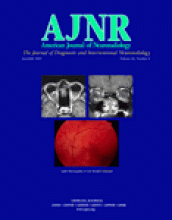Abstract
BACKGROUND AND PURPOSE: Despite improved patient outcomes because of intraarterial fibrinolysis, vertebrobasilar thromboembolism remains a fatal disease with a death rate of more than 50%. The outcome depends on the success of recanalization. Fibrinolysis achieves recanalization in only 50%–70% of the cases. Therefore, we investigated the feasibility of using a coronary mechanical device to increase the recanalization rate.
METHODS: Twelve patients with acute vertebrobasilar occlusion were included in the pilot study. The older 5F and the new 4F versions of the Possis Angiojet catheter, which use a waterjet to attract, fragment, and extract the thrombus, were used. Inclusion depended on the presence of acute multisegmental intracranial or any extracranial vertebrobasilar occlusion. Exclusion criteria included coma lasting >8 hours and age >80. The Angiojet treatment did not exclude other therapeutic options.
RESULTS: The Angiojet catheter accessed the thrombosed site in 10 of 12 patients. Combined treatment with the Angiojet and additional fibrinolysis or angioplasty resulted in a recanalization rate of 100%. Of 37 occluded vertebrobasilar segments, 30 were primarily recanalized with the Angiojet. Three symptomatic and two asymptomatic hemorrhages were detected by CT. Five of the 12 patients died. Fifty percent of all patients obtained a moderate to excellent outcome (Modified Rankin Scale 0–3).
CONCLUSIONS: Use of the coronary Angiojet in the vertebrobasilar system is feasible. The device has the potential to increase the recanalization rate, especially in cases of extensive thrombosis, and, thus, improve patient outcomes.
- Copyright © American Society of Neuroradiology












